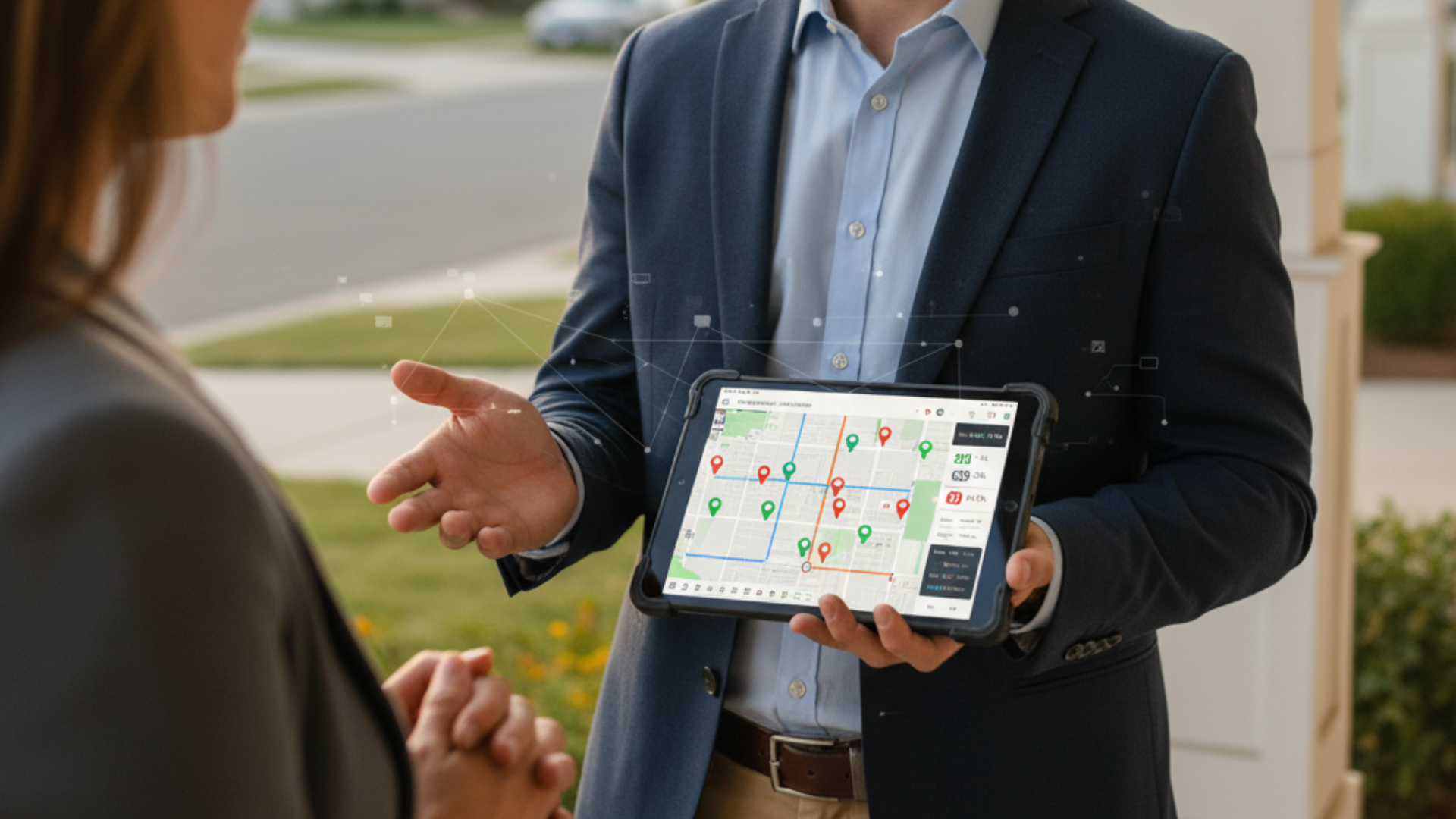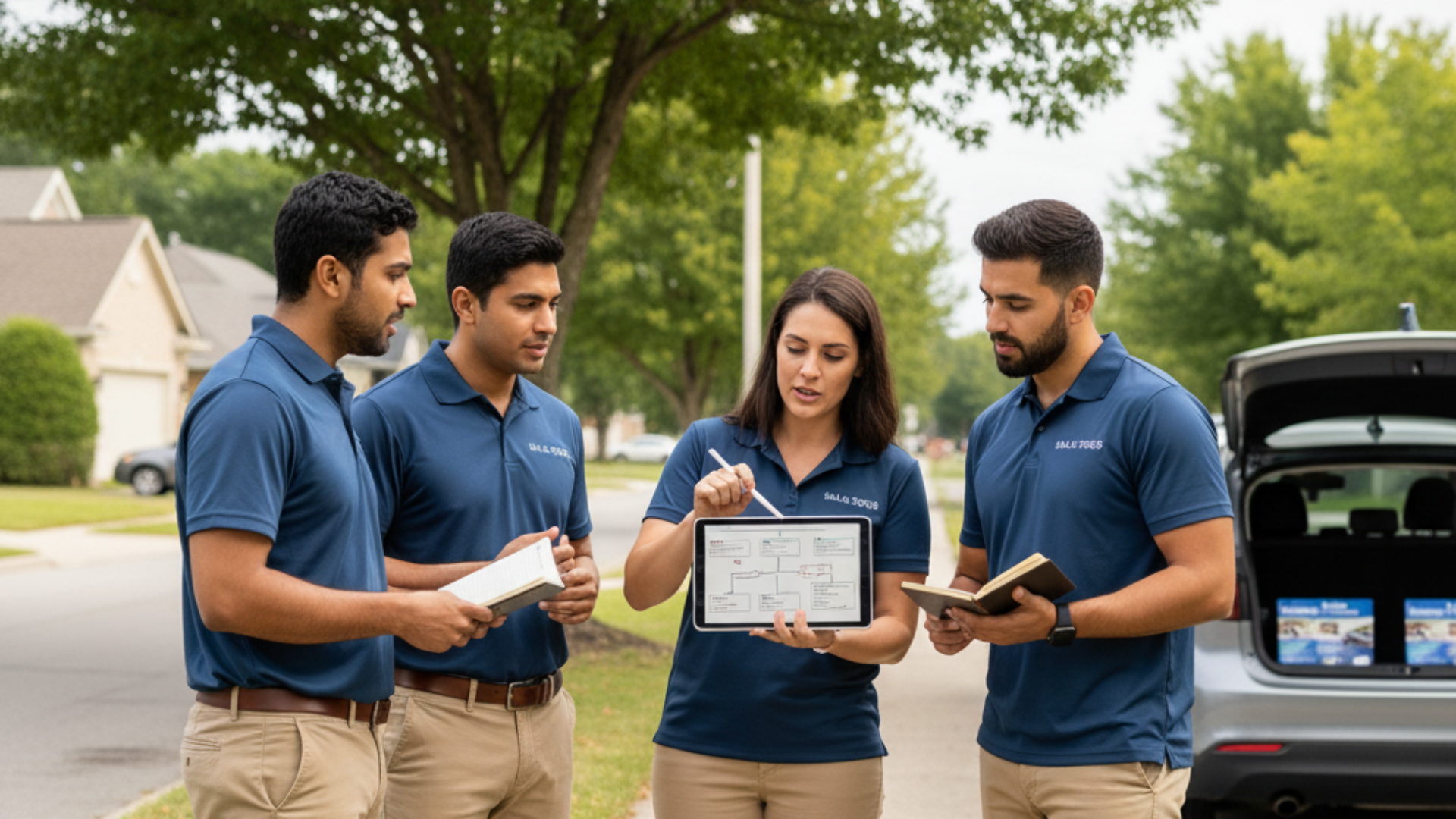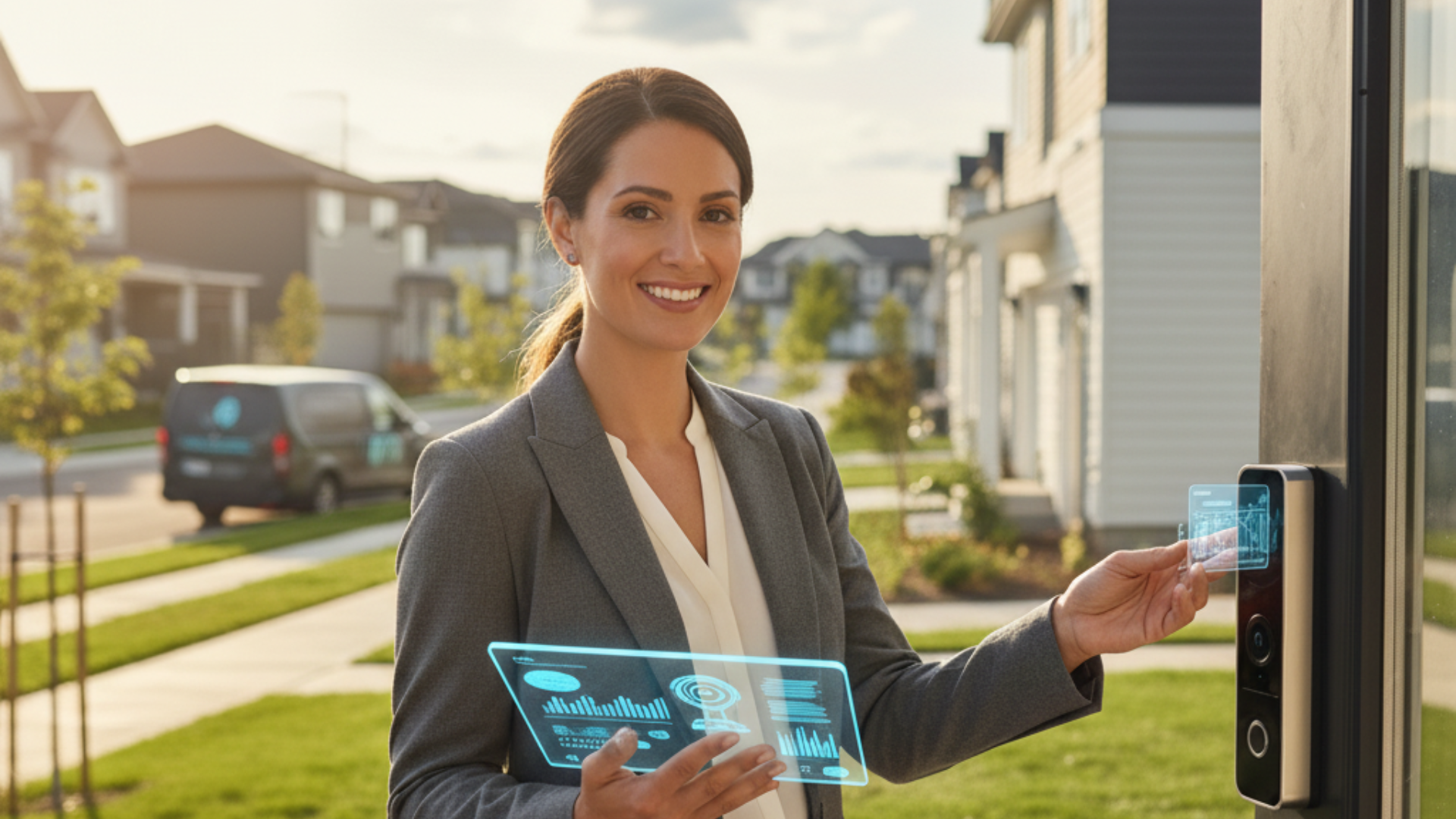Audio overview: Listen & Learn
Why Weather Data Is Your Secret Weapon in Storm Response Sales?
Storm season can flip a roofer’s schedule overnight. Damage is everywhere, calls are flooding in, and competition skyrockets.
The winners? The teams using live weather insights to move first, target smart, and close high-intent storm damage leads, reaching potential customers efficiently.
After every major storm, the same urgent questions flood roofing companies and insurance offices: 'What size hail actually damages roofs?' 'Should I call my roofer or insurer first?' 'How do I file a claim without getting denied?'
These aren't just questions; they highlight specific needs and the difference between getting your roof fixed quickly and affordably versus months of stress, delays, and unexpected costs that you can track.
How to Use Hail Trace Data to Crush Storm Response Sales for Storm Damage Leads
In 2024, an estimated 12 million U.S. homes experienced hail damage, driving a significant surge in roofing repairs, replacements, and storm damage appointments.
By utilizing real-time storm maps supported by data, you can transform the confusion following a storm into a clear opportunity to increase efficiency. This will allow you to reach the right homeowners before others do.
Therefore, this guide will walk you through how tools like Hail Trace, teamed up with modern canvassing software such as Knockbase, help young, tech-driven sales teams succeed in maximizing storm response, booking more exclusive appointments, and boosting ROI, all while delivering genuinely helpful services to stressed homeowners.
Key Takeaway:
- Teams using real-time storm data reach high-intent neighborhoods 24-48 hours faster than competitors relying on guesswork.
- Hail Trace's verified data helps avoid wasted time on undamaged areas while maximizing time spent on genuine opportunities.
- Pre-qualified storm damage leads convert at rates up to 2x higher than generic roofing leads.
- Modern canvassing software like Knockbase, combined with storm data, creates seamless workflows from detection to signed contracts.
- Companies using weather-based marketing and storm data report an increase in lead volume and revenue.
What Is Hail Trace and How Does It Work?
Hail Trace is a storm data platform overlaying real-time and historical storm events on detailed maps, revealing which homes have actually been hit by hail, wind, or tornadoes, providing valuable storm lead.
Unlike old-school radar or basic weather apps, Hail Trace fuses multiple data sources to verify severity and pinpoint impact zones, down to street level. It makes it indispensable for the week following a storm.
Key features roofing teams love:
- Live storm tracking + neighborhood-level hail maps
- Severity ratings for precise risk targeting
- Verified alerts, including wind speed and hail size for each zone
- Integration with sales and canvassing software for instant lead and territory assignment
Why Accuracy Matters: Beyond Surface-Level Storm Alerts
A single bad targeting decision means hours wasted for every rep, walking streets where there's no real damage, while someone else lands urgent claims one block over. Hail Trace’s multi-source, validated data ensures you only knock the right doors, boosting efficiency and morale.
Stats to drop: Over 22% of US residential roof replacements in 2024 were directly caused by hail, wind, or other storm-related damage. Targeting precision grabs these exclusive leads while the need (and homeowner motivation) is hottest, making you a leading provider in storm response.
Why Use Hail Trace Data for Storm Response? The Value Beyond the Surface
- Faster Lead Generation: Real-time, hyperlocal targeting leads to more storm damage appointments, higher conversion rates, and the ability to serve homeowners urgently.
- Win the Race: Teams using live storm data are in neighborhoods making connections while competitors are still playing guesswork.
- Integrated Data = Long-Term Wins: Access to historical storm trends helps your marketing team plan future outreach and insurance claim campaigns.
- Story: After Hurricane Ida, roofers in Louisiana saw a spike overnight, with insurance claims ranging from $17–25B and demand for appointments skyrocketing.
How to Leverage Hail Trace Data with Canvassing Software
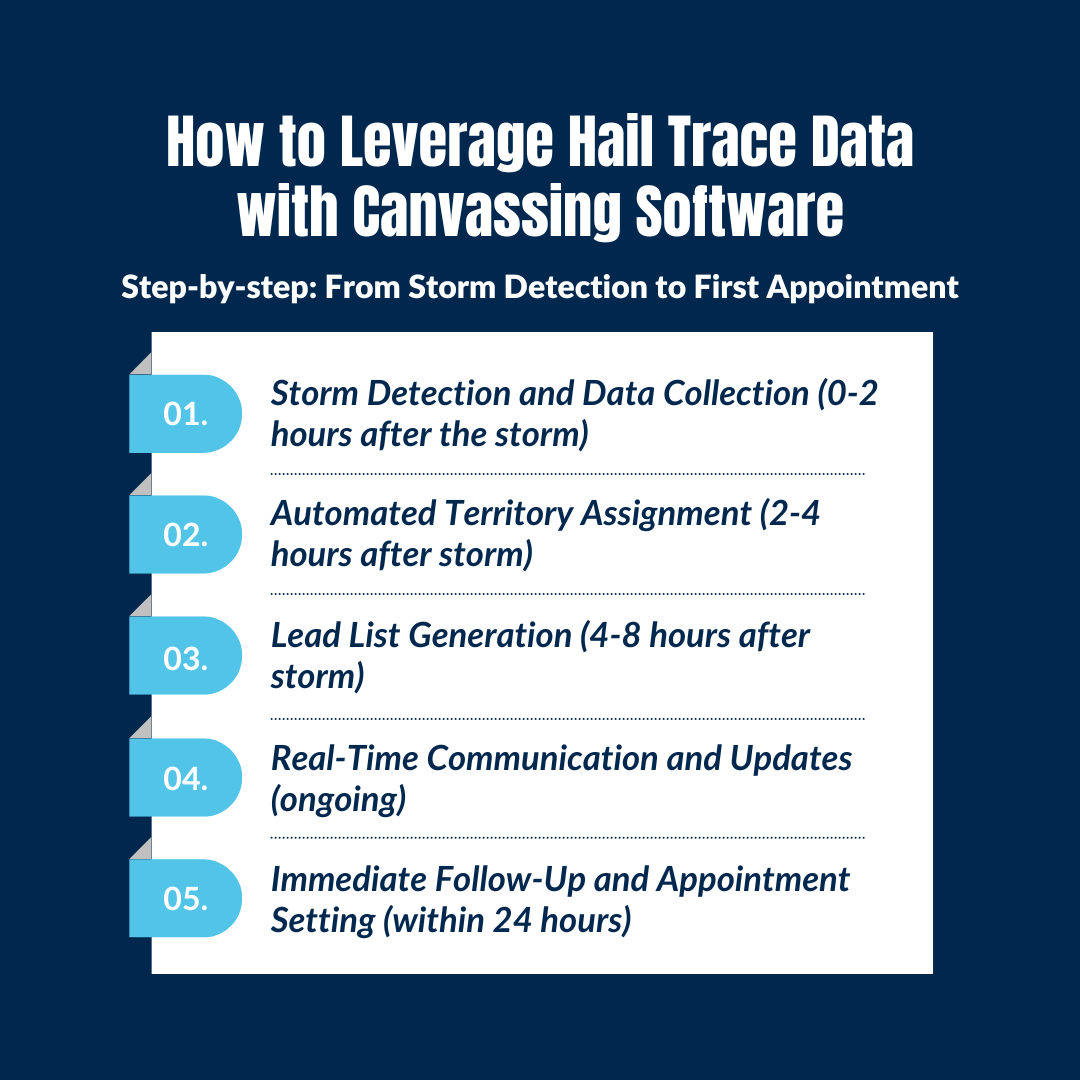
Modern storm response isn't just about having good data; it's about turning that data into immediate action through integrated software systems that eliminate delays and manual errors, utilizing the right resources.
Step-by-step: From Storm Detection to First Appointment
1. Storm Detection and Data Collection (0-2 hours after the storm) are critical for ensuring your success in storm response.
Hail Trace automatically logs storm events as they occur, reporting live hail size, wind speed measurements, and exact geographic impact zones. This data is collected from multiple sources and verified in real-time.
2. Automated Territory Assignment (2-4 hours after storm)
Canvassing platforms like Knockbase instantly overlay this verified storm data on your service area maps, automatically assigning sales reps to the highest-priority impact zones based on damage severity and team capacity.
3. Lead List Generation (4-8 hours after storm)
The system cross-references storm impact data with property databases, insurance information, and homeowner profiles to create prioritized lead lists for each territory, eliminating guesswork about which doors to knock.
4. Real-Time Communication and Updates (ongoing)
Sales reps receive push notifications with lead information, optimal routing, and real-time updates about changing conditions or newly identified damage areas.
5. Immediate Follow-Up and Appointment Setting (within 24 hours)
Integrated communication tools enable faster contact with homeowners via phone, streamlined appointment setting, and automatic follow-up sequences that minimize lost opportunities.
Combining Hail Trace with Canvassing Tools
Platform integration benefits: Modern canvassing software like Knockbase can integrate directly with Hail Trace data for effective lead generation, creating seamless workflows that eliminate manual data entry and reduce the chance of targeting errors.
Territory optimization: Instead of dividing territories by simple geographic boundaries, integrated systems can create territories based on storm damage intensity, allowing you to assign your most experienced reps to the highest-value opportunities.
Must read: How Knockbase’s Hail Trace Integration Helps You Target Storm-Affected Areas Faster
Tactical Tip: Verified Damage Over Weather Alerts
The critical distinction: Assign your team based on verified impact zones with confirmed damage, not just areas that received weather alerts.
Many storms produce dramatic radar signatures but minimal ground damage, while others cause severe localized damage that doesn't show up clearly on basic weather services.
Example scenario: A recent hailstorm might trigger weather alerts for a 50-mile radius, but Hail Trace data reveals that only 8 specific neighborhoods within that
radius actually experienced damage-causing hail. Focusing your entire team on those 8 neighborhoods will produce dramatically better results than spreading efforts across the entire alert zone.
Timeline Example: 24-Hour Storm Response Cycle
- Hour 0-2: Storm passes, Hail Trace begins damage verification
- Hour 2-6: Data integration with canvassing software, territory assignments made
- Hour 6-12: Sales teams deployed to the highest-priority areas
- Hour 12-24: Initial contact with homeowners, appointments scheduled
- Hour 24-48: Follow-up visits, estimates provided, contracts signed
This systematic approach allows successful teams to have signed contracts with their clients in 48 hours of a storm event, while competitors are still figuring out where
to start.
Generating Exclusive, Pre-Qualified Storm Damage Leads with Hail Trace Insights
What makes a lead “exclusive storm damage”? These prospects haven’t been shopped to a dozen other clients, nor to companies. They match tightly to your service area, storm impact footprint, and, thanks to verification tools, these are genuinely in urgent need.
> Pre-qualified means more sales: Homeowners coming from property data and storm alerts are already expecting help, making it far easier to set and keep roofing appointments.
> Conversion rates are higher: Some providers have seen a good percentage of increase in appointment rates and net revenue when using targeted, AI-verified storm data and appointment-setting platforms, helping teams succeed compared to generic leads or cold outreach.
> Real-world ROI: A roofing company doubled its lead count in three months using smart, personalized outreach, and others saw 300% more leads and a 67% conversion rate in year-over-year comparisons.
Best Practices for Engaging Storm-Damaged Homeowners
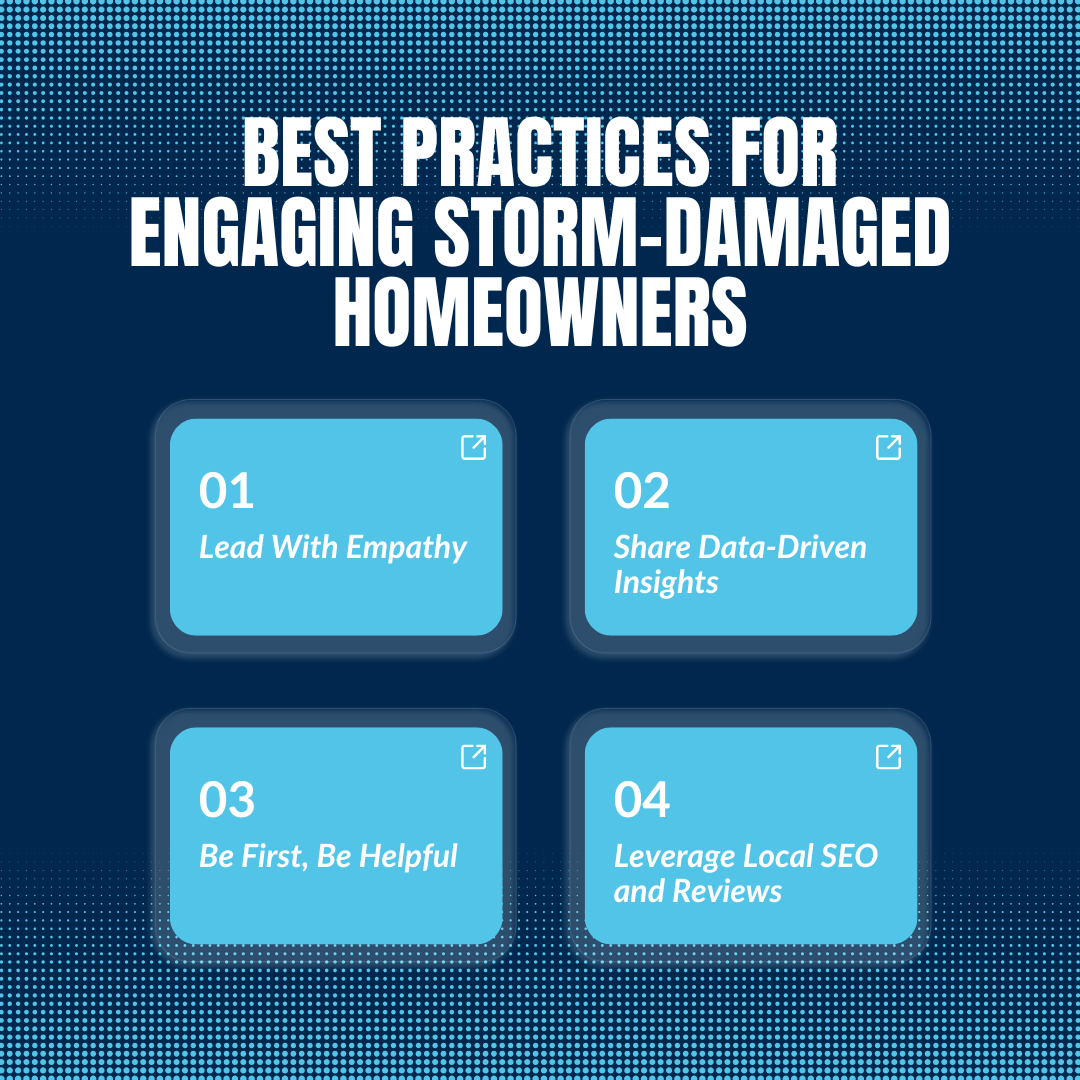
1. Lead With Empathy: Fear and anxiety are high right after a storm. Listen first, offer reassurance, and always emphasize safety and trust.
2. Share Data-Driven Insights: Homeowners love seeing that you know exactly why you're there and how you identified their need (thanks to Hail Trace data).
3. Be First, Be Helpful: Most successful D2D roofers contact storm-impacted owners within 24 hours, often using automated booking tools to speed up scheduling.
4. Leverage Local SEO and Reviews: Stats show most homeowners choose a roofer based on online reputation, make sure yours demonstrates genuine post-storm expertise and customer care.
Overcoming Challenges: Common Pitfalls and How to Avoid Them
- Misreading Hail Maps: Skip ambiguous radar snapshots. Verified storm data cuts costly mistakes and builds trust, ensuring your service is complete.
- Lead Saturation: The best defense is speed and exclusivity, using tech to move before the crowd and secure your business.
- Overwhelmed Teams: Platforms like Knockbase automate territory assignments and follow-up. Some teams see 30% more homes canvassed per day using optimized routing.
What the Data Says: Storm Damage Lead Generation Statistics & Trends
Understanding industry trends and performance benchmarks helps roofing teams set realistic goals, respond effectively, and identify opportunities for improvement.
Current data shows significant opportunities for teams willing to embrace technology-driven approaches.
Market Size and Opportunity Analysis
Industry scale: The US roofing market reached $59.2 billion in 2024, with residential roofing accounting for the majority of that revenue. Storm damage represents a significant and growing portion of this market.
Storm damage impact statistics:
- Storm damage events caused 22% of all roof replacements in 2024
- Over 12 million US properties suffered hail damage in 2024
- Storm-hit regions typically see a 65% spike in insurance claims within nine months of major weather events
- The global roofing market is growing at a 4.2% CAGR, reaching $192.8 billion by 2032
Weather Pattern and Damage Trends
Increasing storm frequency: Climate data shows increasing frequency and intensity of severe weather events, particularly in traditional "hail alley" states, but also expanding into previously less-affected regions.
2024 weather impact data:
- 2024 was an active year for billion-dollar weather disasters in the US
- Severe convective storms (including hail) caused record insurance payouts
- Traditional storm seasons are extending, creating longer opportunity windows for contractors
ROI and revenue data: (Source)
- Companies using exclusive appointment-setting tools report up to double the revenue and 70% more leads compared to traditional methods
- Teams combining storm data with automated marketing see 30-70% increases in lead volume
Technology Adoption Trends
Digital transformation statistics:
- Roofing companies using integrated CRM a nd canvassing software report 30% higher productivity
- Teams with real-time storm data integration arrive 24-48 hours faster in affected areas
- Mobile-first canvassing tools reduce administrative time by up to 40%
Generational preferences: Young, tech-savvy roofing teams (ages 18-35) across the country are rapidly adopting integrated storm response tools, often outperforming
larger, traditional companies that rely on manual processes.
How Knockbase Helps You Increase Business Efficiency Using Storm Data
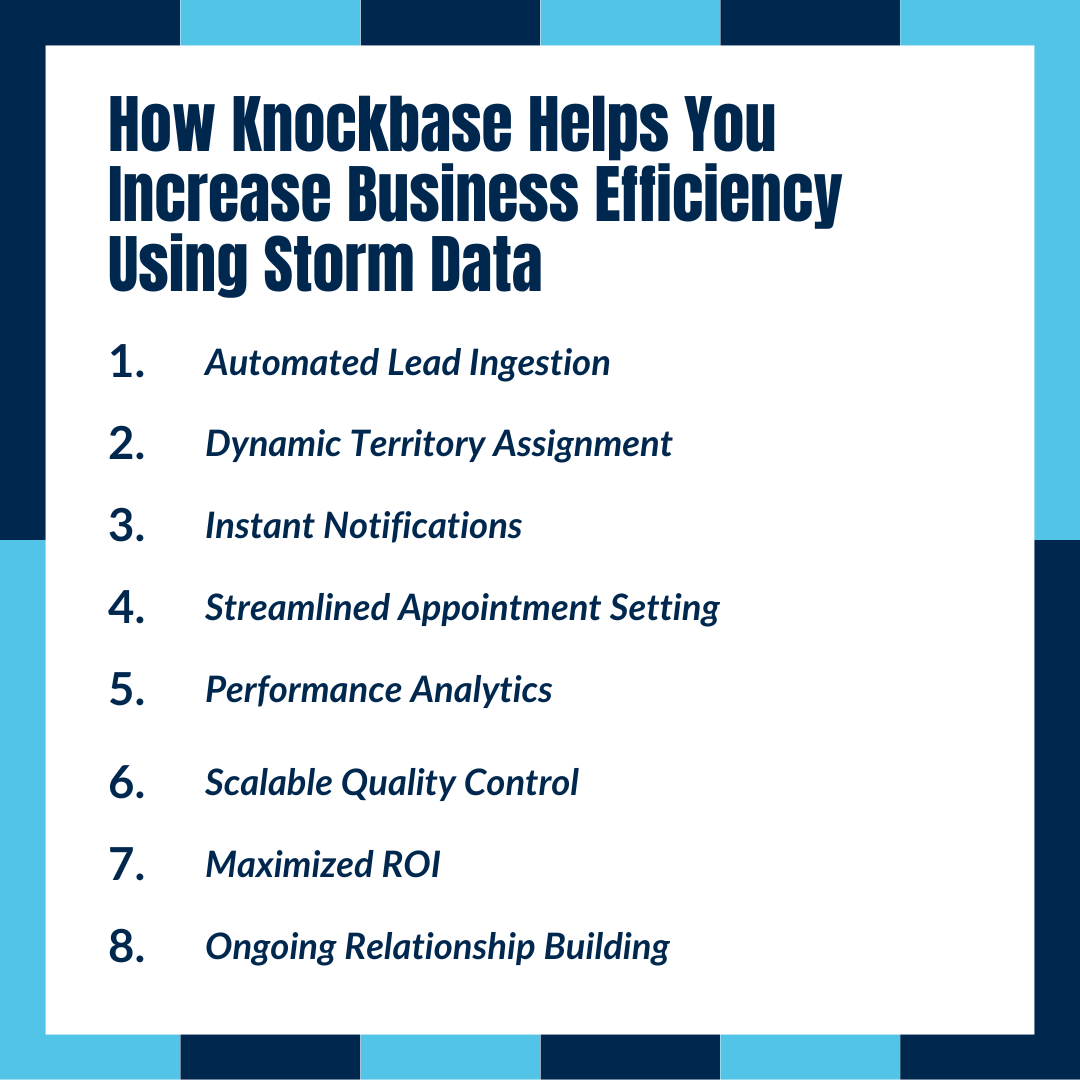
Knockbase turns storm response into a seamless, data-driven lead service, empowering your team to connect with property owners and decision makers swiftly and effectively, providing ongoing support.
1. Automated Lead Ingestion
Hail Trace storm data flows directly into Knockbase, matching impact zones with homeowner profiles and insurance status. Reps focus only on high-intent, exclusive storm leads.
2. Dynamic Territory Assignment
Real-time damage ratings redraw canvassing routes by severity and team availability. This precision targeting cuts travel time and maximizes daily appointments.
3. Instant Notifications
Push alerts keep reps updated on new damage zones, appointment confirmations, and routing changes, ensuring no request goes unanswered.
4. Streamlined Appointment Setting
Built-in calling and SMS tools let reps schedule, confirm, and log estimates without switching apps. Automated reminders and educational content boost booking rates.
5. Performance Analytics
Visual dashboards track contact attempts, conversion rates, and revenue per lead. Managers spot trends, replicate top performers, and drive continuous improvement.
6. Scalable Quality Control
Standardized checklists and geo-tagged photos ensure consistent, compliant damage assessments, maintaining trust and speeding claims.
7. Maximized ROI
Hyperlocal campaigns, digital ads, direct mail, SMS, target storm-impacted neighborhoods, delivering up to 8× higher returns than generic marketing.
8. Ongoing Relationship Building
Beyond initial response, automated maintenance reminders, and referral programs, Knockbase keeps your brand top-of-mind and helps you move forward, maximizing lifetime customer value.
Conclusion: Turn Every Storm Into Opportunity With Smart Weather Insights
Storm seasons aren’t slowing down, but neither are the digital tools that help you win more business, serve homeowners faster, and stand out in a crowded market.
Teams who embrace precise weather data, fast-moving software, and a service-first approach won’t just weather the storm; they’ll thrive because of it.
About Knockbase
Knockbase is purpose-built for busy roofing and storm response teams to connect with homeowners effectively. Integrated with Hail Trace and other live weather tools, it simplifies post-storm sales, giving you the power to be first to help, every time.
Ready to dominate storm response? Start integrating Hail Trace and Knockbase into your sales process and see appointment rates, conversion, and revenue surge, all while providing real help to homeowners who need it most.
FAQs
How do I find a reputable storm damage contractor?
Look for local companies with excellent reviews, industry certifications, and transparent communication to address your storm damage needs. Ask if they use storm verification tools so you know your repair is actually needed and covered.
Does storm damage increase insurance?
Insurance rates may rise in regions with frequent claims or catastrophic losses, but immediate coverage and prompt claims management are essential for a timely, fair roof replacement.
What’s the average cost of storm damage repair?
In 2024, typical asphalt shingle replacements cost $5,000–$10,000, while larger or specialty jobs can be more. Most storm repairs are covered by insurance if filed quickly and properly, meeting the demand for timely repairs.
What is the most common storm damage?
Hail and wind are the top drivers of exclusive storm damage, with over 12 million US homes affected by hail in 2024, often leading to leaks, broken shingles, and urgent repairs.






